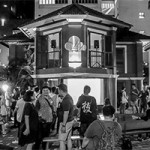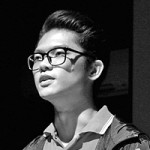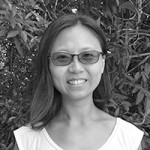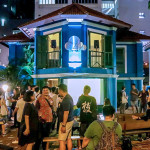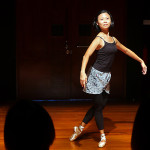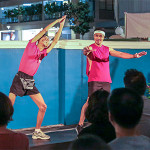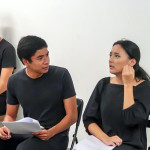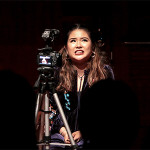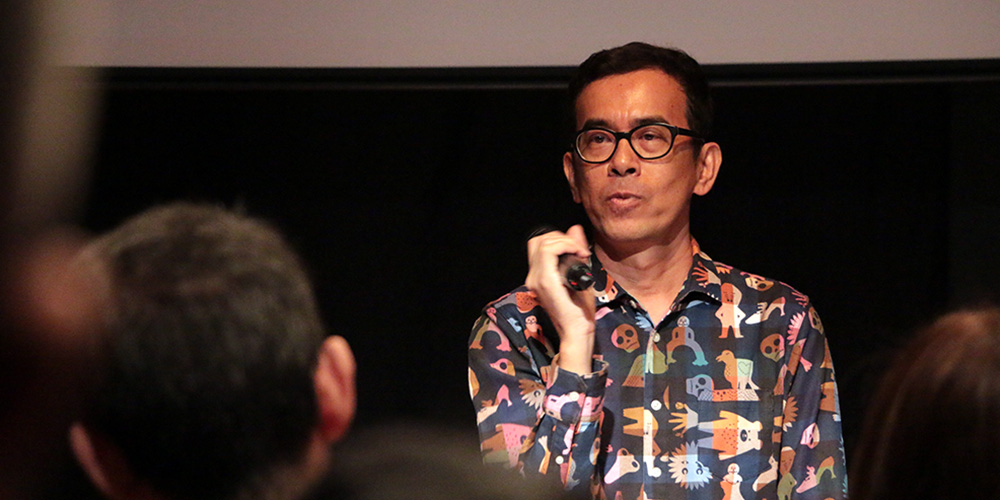
Neo Kim Seng at a post-show dialogue with audiences at “The Vault: My Grandfather’s Road” (2017).
By Neo Kim Seng
Published on 14 January 2020
I only remember two shows I watched at Action Theatre at 42 Waterloo Street. The first was Alfian Sa’at The Optic Trilogy in 2001. The set included a few CRT TVs and I was quite impressed by the way they were used in the production. The other show was Yak Aik Wee’s Streetwalkers in 2009. That was also the last time I visited 42 Waterloo Street before it closed in 2012.
In Centre 42’s first year of operation, I felt it operated like an underground exclusive members only club and the general public, even myself, didn’t know much about its activities. Then the Centre started organising more events, many people came and it has been that busy ever since.
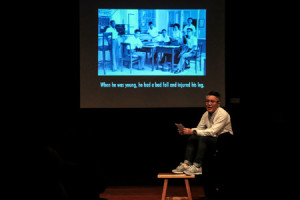
Actor Tan Cher Kian performing the Malaysian Cantonese version of “The Vault: My Grandfather’s Road” (2017).
I first approached Centre 42 about the Cantonese version of My Grandfather’s Road (MGR) in early 2017. I wasn’t quite sure when Centre 42 proposed that MGR be presented under The Vault’s platform as The Vault was more looking at responses to established local texts. MGR was written and published only in 2015, but I guess it qualified because it was my response to the English text.
White Rabbit, Red Rabbit by Nassim Soleimanpour and An Oak Tree by Tim Crouch inspired me to experiment with the idea that MGR should not be over-rehearsed to keep MGR’s sincerity and raw emotions. These two plays featured performers who were only handed the script just moments before the performance or fed lines via an earpiece. I really appreciated the vulnerability and sincerity of the performers in those two productions.
I did not want to work with seasoned actors for the Cantonese version. I wanted to work with new blood and then see them grow in their own ways – I do this in my other work as well, for example in programming. So I worked with Bjorn Lee Varella (2015) and Tan Cher Kian aka CK (2017, 2018) and Gary Tang (2017, 2018), as they were quite new on stage or last acted a long time ago. Another important criteria for all the performers was that I didn’t know them previously.
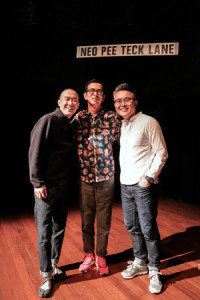
Kim Seng (centre) with actors Gary Tang (left) and Tan Cher Kian (right) beneath the Neo Pee Teck Lane street sign at “The Vault: My Grandather’s Road” (2017).
For the English version, I asked Karen Tan (2018, 2019) and Loong Seng Onn (2019) to come onboard as I wanted to try something else. I’ve never shared my personal stories with them before. How would this new knowledge affect how they see me and the character(s) they play on stage? I would need to work with actors I’m familiar and comfortable with for this to work, and I’ve known Karen and Seng Onn for almost 30 years.
Karen and I spent a lot of time sharing our own stories. This was very important because it help to open up new possibilities and explorations. Karen helped a lot to clarify and restructure the script for the 2018 version, also performed at Centre 42. Seng Onn came onboard in late 2018 and the final performance structure of the English script for the 2019 version (part of the Esplanade’s The Studios season) was his doing. During one Saturday afternoon, instead of rehearsing, he broke down the stories into its essential parts on the white board at Centre 42 and asked me to restructure and rewrite the piece. So Karen and Seng Onn were my dramaturgs.
The different Cantonese versions were developed in three phases over two years. I deliberately kept a distance from CK and Gary while working on the first staging in 2017, to allow themselves to find my voice in the piece themselves. But by the second and third iterations (in 2018 and 2019 respectively), we became more comfortable with each other, and just like Karen, they started interrogating me about my life. We traded stories and some of their own stories were incorporated into the script.
During one of the warm-up sessions before the Cantonese performance in 2018, Karen said that I should consider putting CK and Gary together on stage as they have very different energies. That was how the Cantonese duologue for Esplanade in 2019 came about. (The idea for the English duologue came shortly after that!) CK, Gary and I brainstormed the new version and how to make it coherent. Some sections of the script were written on-site at Centre 42, some were homework for them.
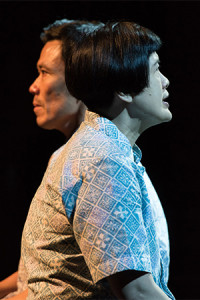
Actors Loong Seng Onn and Karen Tan performing the English duologue version of “My Grandfather’s Road (RHDS)” (2019).
Photo: Law Kian Yan
The brown wooden benches of Centre 42 have been an essential part of the MGR set since 2017, and have naturally evolved as part of MGR because of their versatility as we found different ways of using them. The 2017 and 2018 presentations used one table and two stools to evoke the one-table two-chairs idea of storytelling – simple props to support the stories.
Why am I telling all these Centre 42 and MGR stories that took place at 42 Waterloo Street? It is a place where I found out more about myself when I opened up to my actors in a way never before, even with my own family.
It is a place where I shared intimate personal stories with CK, Gary, Karen and Seng Onn, many of them will stay within the rooms of 42 Waterloo Street.
It is a place where friends and strangers found out about me, even more so than the years they know me.
It is a place where I Instagram-ed a Singaporean mango. (It’s the only local fruit in my ongoing Instagram project about the origins and journeys of fruits found in Singapore.)
It is a place where I started to research more about and reconnect with my family and long-lost relatives and friends, my mother tongue, Cantonese, and my roots.
It is place where I had to choose between truth and honesty.

Neo Kim Seng is a crossdisciplinary practitioner who has been involved in independent and large-scale projects in various capacities in Singapore and overseas since 1987. Besides fruit, he has also documented his journey with “My Grandfather’s Road”.
Read the other essays in this series about the blue house on 42 Waterloo Street:

